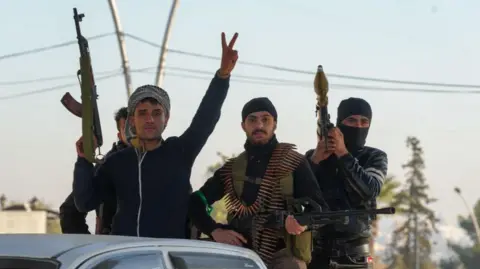Who are Hayat Tahrir al-Sham, the rebels who took control of Aleppo?

 Getty Images
Getty ImagesRebel forces launched the biggest attack on the Syrian government in years on Wednesday.
By Sunday, they had taken control of “large parts” of the country's second largest city, Aleppo it continues towards Hama in the south.
The surprise attack prompted the first Russian strikes on Aleppo since 2016, and saw the Syrian army withdraw its troops from the city.
The attack was led by the Islamic terrorist group Hayat Tahrir al-Sham (HTS) – which has a long history of involvement in the Syrian conflict.
Who is Hayat Tahrir al-Sham?
 Reuters
ReutersHTS was organized under a different name, Jabhat al-Nusrain 2011 as a direct affiliate of Al Qaeda.
The leader of the so-called Islamic State (IS), Abu Bakr al-Baghdadiwas also involved in its formation.
It was considered one of the most effective and deadly groups opposing President Assad.
But its jihadist ideology proved stronger than revolutionary fervor – and it was seen at the time as a counter to the main coalition of rebels under the banner of Free Syria.
And in 2016, the group's leader, Abu Mohammed al-Jawlani, publicly broke with Al Qaeda, disbanded Jabhat al-Nusra and established a new organizationwhich took the name Hayat Tahrir al-Sham when it merged with several other similar groups a year later.
Who is in charge of Syria?

The war in Syria for the past four years has felt like it is over.
President Bashar al-Assad's rule is not contested in the country's major cities, while other parts of Syria are still under his control.
This includes many Kurdish areas in the east, which have been more or less separated from Syrian regime control since the early years of the conflict.
There has been ongoing, if muted, unrest in the south where Assad's uprising began in 2011.
In Syria's vast desert, fighters from the so-called Islamic State group still pose a security risk, especially during truffle hunting when people travel to the area to find two of the most lucrative foods.
And in the northwest, the province of Idlib is held by militant groups that were driven there during the heat of the war.
HTS, the ruling force in Idlib, launched a surprise attack on Aleppo.
A bitter fight
For several years, Idlib remained a battlefield as Syrian government forces tried to regain control.
But the 2020 ceasefire agreement made by Russiait has long been Assad's main ally, while Turkey, which backs the rebels, remains a constant.
About four million people live there – most of them displaced from the towns and cities that Assad's forces won from the rebels in a brutal war.
Aleppo was one of the bloodiest battlefields and represents the biggest defeat for the rebels.
To achieve victory, Assad is relying on Russian air power and Iranian military support on the ground – mostly through Iranian-sponsored forces.
These include Hezbollah.
There is no doubt that the recent setbacks Hezbollah has experienced Israel's invasion of Lebanonand Israeli strikes on Iranian military commanders in Syria, played a major role in the decision of jihadists and rebel groups in Idlib to make their unexpected move to Aleppo.
 Getty Images
Getty ImagesFor some time now, HTS has established its power base in Idlib where it is the de facto local authority, although its attempts at legitimacy have been marred by allegations of human rights abuses.
It has also been involved in some bitter conflicts with other groups.
Its ambitions beyond Idlib were unclear.
Since breaking away from Al Qaeda, its mission has been limited to trying to establish basic Islamic rule in Syria rather than a comprehensive caliphate, as IS tried and failed to do.
It has shown little sign of trying to dominate Syria's conflict on a larger scale and renew its challenge to Assad's rule over much of the country – until now.
Additional reporting by Maia Davies.
Source link




